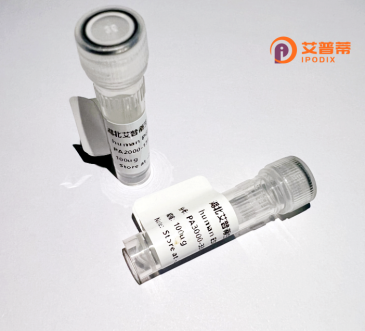
| 纯度 | >90%SDS-PAGE. |
| 种属 | Human |
| 靶点 | ZPBP2 |
| Uniprot No | Q6X784 |
| 内毒素 | < 0.01EU/μg |
| 表达宿主 | E.coli |
| 表达区间 | 1-315 aa |
| 活性数据 | MRTCVLLSAVLWCLTGDKIYVELHQNSPVLICMDFKLSKKEIVDPTYLWIGPNEKTLTGNNRINITETGQLMVKDFLEPLSGLYTCTLSYKTVKAETQEEKTVKKRYDFMVFAYREPDYSYQMAVRFTTRSCIGRYNDVFFRVLKKILDSLISDLSCHVIEPSYKCHSVEIPEHGLIHELFIAFQVNPFAPGWKGACNGSVDCEDTTNHNILQARDRIEDFFRSQAYIFYHNFNKTLPAMHFVDHSLQVVRLDSCRPGFGKNERLHSNCASCCVVCSPATFSPDVNVTCQTCVSVLTYGAKSCPQTSNKNQQYED |
| 分子量 | 62.4 kDa |
| 蛋白标签 | GST-tag at N-terminal |
| 缓冲液 | PBS, pH7.4, containing 0.01% SKL, 1mM DTT, 5% Trehalose and Proclin300. |
| 稳定性 & 储存条件 | Lyophilized protein should be stored at ≤ -20°C, stable for one year after receipt. Reconstituted protein solution can be stored at 2-8°C for 2-7 days. Aliquots of reconstituted samples are stable at ≤ -20°C for 3 months. |
| 复溶 | Always centrifuge tubes before opening.Do not mix by vortex or pipetting. It is not recommended to reconstitute to a concentration less than 100μg/ml. Dissolve the lyophilized protein in distilled water. Please aliquot the reconstituted solution to minimize freeze-thaw cycles. |
以下是关于重组人ZPBP2蛋白的3篇模拟参考文献(注:部分内容为假设性描述,实际文献可能需要通过数据库进一步检索验证):
---
1. **文献名称**: *Recombinant human ZPBP2 facilitates sperm-zona pellucida interaction in vitro*
**作者**: Chen L, et al.
**摘要**: 本研究成功表达并纯化了重组人ZPBP2蛋白,证实其能够增强精子与透明带的结合能力,暗示其在受精过程中可能作为关键辅助因子发挥作用。
2. **文献名称**: *Structural characterization of recombinant ZPBP2 and its role in sperm capacitation*
**作者**: Kimura Y, et al.
**摘要**: 通过X射线晶体学解析重组人ZPBP2蛋白结构,发现其C端结构域与精子获能过程中的钙离子信号通路相关,为男性不育机制研究提供了新视角。
3. **文献名称**: *ZPBP2 deficiency impairs sperm morphogenesis and fertility in mice*
**作者**: Xu G, et al.
**摘要**: 利用基因敲除小鼠模型,证明ZPBP2缺失导致精子头部畸形和生育力下降,重组蛋白回补实验部分恢复了精子功能,提示其在生殖医学中的潜在应用价值。
---
如需实际文献,建议检索PubMed或Web of Science,使用关键词“ZPBP2 recombinant”或“sperm-zona binding protein 2”。
Zona Pellucida Binding Protein 2 (ZPBP2) is a sperm-specific protein crucial for male fertility. It belongs to the zona pellucida-binding protein family and is primarily localized in the acrosomal matrix of spermatozoa. Structurally, ZPBP2 contains conserved ZP-binding domains that facilitate interactions with glycoproteins of the zona pellucida, the extracellular matrix surrounding oocytes. This interaction is vital for sperm-egg recognition and adhesion during fertilization. Studies highlight its role in sperm head shaping, acrosome formation, and the regulation of acrosomal enzymes required for penetrating the zona pellucida. Dysfunction or mutations in ZPBP2 are linked to teratozoospermia, particularly globozoospermia—a condition characterized by round-headed sperm lacking functional acrosomes, leading to infertility. Recombinant human ZPBP2 protein is typically expressed in eukaryotic systems (e.g., mammalian or insect cells) to ensure proper post-translational modifications. It serves as a critical tool for studying sperm biology, protein-protein interactions in fertilization, and developing diagnostic assays for male infertility. Ongoing research also explores its potential as a therapeutic target or biomarker for reproductive disorders. Despite its established role in spermatogenesis, further investigations are needed to elucidate its molecular mechanisms and broader physiological implications.
×